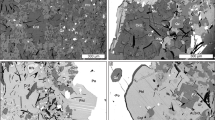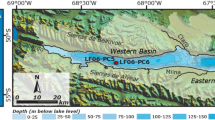Abstract
Distinct pyrites have been recovered from a shallow sediment core from Site 4B in the Shenhu area of the northern South China Sea. Based on the lithology, texture and structure of sediments, the stable sulfur isotope of pyrite and the total organic carbon (TOC) concentration of the sediments, a distinctive sediment interface is identified at a depth of about 1 m below the seafloor in the core sediments. The pyrites only accumulate in the lower part of the core as rods and foraminifera-infillings, and mainly within three intervals marked by high pyrite concentrations. The amount of pyrite in the sediments shows no remarkable correlation with TOC in the Site 4B core sediments. The stable sulfur isotopes of the pyrite have extremely negative values ranging from −41.69‰ to −49.16‰. They are considered to be the mutual product of sulfate bacterial reduction and sulfur bacterial disproportionation. Our research proposes that Site 4B might be located in or near a possible mud volcano sedimentary environment; a large amount of methane could migrate from deep to shallow sediments in an active mud volcano and thereby play a key role in the intensity of sulfate bacterial reduction and the amount of pyrite formed at Site 4B. Further, the variation in flux of deep methane fluid by intermittent mud volcanic eruptions might result in the deposition of authigenic pyrite intervals.
Similar content being viewed by others
References
Zhang J L, Zhang P Z. A discussion of pyrite catalysis on the hydrocarbon generation progress (in Chinese). Adv Earth Sci, 1996, 11: 282–287
Rasmussen B. Evidence for pervasive petroleum generation and migration in 3.2 and 2.63 Ga shales. Geology, 2005, 33: 497–500
Liu J, Lu H F, Liao Z L, et al. Distribution of sulfides in shallow sediments in Dongsha area, South China Sea, and its relationship to gas hydrates (in Chinese). Earth Sci Front, 2005, 12: 258–262
Chen D F, Feng D, Su Z, et al. Pyrite crystallization in seep carbonates at gas vent and hydrate site. Mater Sci Eng C, 2006, 26: 602–605
Chen Z, Yan W, Chen M H, et al. Formation of authigenic gypsum and pyrite assemblage and its significance to gas venting in Nansha trough, South China Sea (in Chinese). Mar Geol Quat Geol, 2007, 27: 91–100
Pu X Q, Zhong S J, Yu W Q, et al. Authigenic sulfide minerals and their sulfur isotopes in sediments of the northern continental slope of the South China Sea and their implications for methane flux and gas hydrate formation. Chin Sci Bull, 2007, 52: 401–407
Wignall P B, Newton R. Pyrite framboid diameter as a measure of oxygen deficiency in ancient mudrocks. Am J Sci, 1998, 298: 537–552
Bond D P G, Wignall P B. Pyrite framboid study of marine Permian-Triassic boundary sections: A complex anoxic event and its relationship to contemporaneous mass extinction. Geol Soc Am Bull, 2010, 122: 1265–1279
Sassen R, MacDonald I R, Guinasso N L J, et al. Bacterial methane oxidation in sea-floor gas hydrate: Significance to life in extreme environments. Geology, 1998, 26: 851–854
Schieber J. Sedimentary pyrite: A window into the microbial past. Geology, 2002, 30: 531–534
Xiao S H, Schiffbauer J D, McFadden K A, et al. Petrographic and SIMS pyrite sulfur isotope analyses of Ediacaran chert nodules: Implications for microbial processes in pyrite rim formation, silicification, and exceptional fossil preservation. Earth Planet Sci Lett, 2010, 297: 481–495
Chambers L A, Trudinger P A. Microbiological fractionation of stable sulfur isotopes: A review and critique. Geomicrobiol J, 1979, 1: 249–293
Berner R A. Early Diagenesis: A Theoretical Approach. Princeton, NJ: Princeton University Press, 1980. 1–239
Berner R A. Sedimentary pyrite formation: An update. Geochim Cosmochim Acta, 1984, 48: 605–615
Ohmoto H, Kaiser C J, Geer K A. Systematics of sulphur isotopes in recent marine sediments and ancient sediment-hosted basemetal deposits. In: Herbert H M, Ho S E, eds. Stable Isotopes and Fluid Processes in Mineralization. Perth: The University Western Australia Press, 1990. 70–120
Habicht K S, Canfield D E. Isotope fractionation by sulfate-reducing natural populations and the isotopic composition of sulfide in marine sediments. Geology, 2001, 29: 555–558
Chang H J, Chu X L, Huang J, et al. Sulfur isotope fractionation accompanying bacterial action under sedimentary condition (in Chinese). Geol Rev, 2007, 53: 807–813
Chen F, Su X, Nurnberg D, et al. Lithologic features of sediments characterized by high sedimentation rates since the last glacial maximum from Dongsha Area of the South China Sea (in Chinese). Mar Geol Quat Geol, 2006, 26: 9–17
Luan X W, Peng X C, Qiu Y. Tectonic Control on the Formation of High-deposition-rate Sediment Drift in the Northern Slope of the South China Sea (in Chinese). Geoscience 2009, 23: 183–198
Lu H F, Liu J, Chen F, et al. Authigenic pyrites from the shallow sediments in Dongsha Area of South China Sea: Implications for gas hydrates occurrence (in Chinese). Geol Res South China Sea, 2007, 1: 48–53
Lu H F, Chen F, Liao Z L, et al. Authigenic pyrite rods from the core HD196A in the northeastern South China Sea (in Chinese). Acta Geol Sin, 2007, 81: 519–525
Wu S G, Liu Z, Wang W Y, et al. Late Cenozoic tectonic deformation in the Dongsha Islands and adjacent sea area. Chin J Oceanol Limnol, 2003, 21: 377–388
Yao B C, Wan L, Wu N Y. Cenozoic plate tectonic activities in the Great South China Sea area (in Chinese). Geol Chin, 2004, 31: 113–122
Li Q Y, Zheng H B, Zhong G F, et al. Tectonic events indicated by late oligocene slumped deposits from the South China Sea (in Chinese). Earth Sci, 2005, 30: 19–24
Shao L, Pang X, Zhang G C. Late Oligocene tectonic event in the Northern South China Sea and its implications (in Chinese). Earth Sci, 2009, 34: 717–724
Huang Y Y, Suess E, Wu N Y, et al. Marine and Gas Hydrate Geology of the Northern South China Sea: Sino-German Cooperative SO-177 Cruise Report (in Chinese). Beijing: Geological Publishing House, 2008
Su X, Chen F, Yu X H, et al. A pilot study on Miocene through Holocene sediments from the continental slope of the South China Sea in correlation with possible distribution of gas hydrates (in Chinese). Geoscience, 2005, 19: 1–13
Wu N Y, Zhang H Q, Yang S X, et al. Preliminary discussion on natural Gas Hydrate (NGH) reservoir system of Shenhu Area, north slope of South China Sea (in Chinese). Nat Gas Indust, 2007, 27: 1–6
Su Z, Pang X, Zhong Z H, et al. Dynamics of Tertiary tectonic evolution of the Baiyun Sag in the Pearl River Mouth Basin (in Chinese). Earth Sci Front, 2005, 12: 489–498
Wang J H, Pang X, Wang H B, et al. Discovery and Recognition of the central diapiric zone in Baiyun Depression, Pearl River Mouth Basin. Earth Sci, 2006, 31: 209–213
Shi W Z, Song Z F, Wang X L, et al. Diapir structure and its origin in the Baiyun Depression, Pearl River Mouth Basin (in Chinese). Chin Earth Sci, 2009, 34: 778–784
Wu N Y, Yang S X, Wang H B, et al. Gas-bearing fluid influx sub-system for gas hydrate geological system in Shenhu Area, Northern South China Sea (in Chinese). Chin J Geophys, 2009, 52: 1641–1650
Wang P X, Prell W L, Blum P, et al. Proceedings of Ocean Drilling Program, Initial Reports Volume 184, 2000
Lu H F. Mineralogical and geochemical studies on sediments from Dongsha Area, South China Sea: Evidence for gas hydrate occurrence. Dissertation for the Doctoral Degree. Guangzhou: Sun Yat-Sen University, 2007
Lim Y C, Lin S, Yang T F, et al. Variations of methane induced pyrite formation in the accretionary wedge sediments offshore southwestern Taiwan. Mar Petrol Geol, 2011, 28: 1829–1837
Goldhaber M B, Kaplan I R. Controls and consequences of sulfate reduction rates in recent marine sediments. Soil Sci, 1975, 119: 42–55
Habicht K S, Canfield D E. Sulfur isotope fractionation during bacterial sulfate reduction in organic-rich sediments. Geochim Cosmochim Acta, 1997, 61: 5351–5361
Rees C E, Jenkins W J, Monster J. The sulphur isotopic composition of ocean water sulphate. Geochim Cosmochim Acta, 1978, 42: 377–381
Detmers J, Brüchert V, Habicht K S, et al. Diversity of sulfur isotope fractionations by sulfate-reducing prokaryotes. Appl Environ Microbiol, 2001, 67: 888–894
Canfield D E, Thamdrup B. The production of 34S-depleted sulfide during bacterial disproportionation of elemental sulfur. Science, 1994, 266: 1973–1975
Huang H G, Di P F, Chen D F, et al. Global distribution and research progress of mud volcanoes (in Chinese). Bull Miner Petrol Geochem, 2011, 30: 189–197
He J X, Zhu Y H, Weng J N, et al. Characters of north-west mud diapir volcanoes in South China Sea and relatiohship between their accumulation and migration of oil and gas. Earth Sci, 2010, 35: 75–86
Milkov A V. Worldwide distribution of submarine mud volcanoes and associated gas hydrates. Mar Geol, 2000, 167: 29–42
Wang L F, Sha Z B, Liang J Q, et al. Analysis of gas hydrate absence induced by the late-stage diapir domination in the borehole Sh5 of shenhu area. Geoscience, 2010, 24: 450–456
Zhang M, Sun X M, Lu Y, et al. Mineralogy of authigenic tube pyrite from the Southwest Taiwan Basin of South China Sea and its tracing significance for gas hydrates. Miner Depos, 2011, 30: 725–734
Author information
Authors and Affiliations
Corresponding author
Rights and permissions
About this article
Cite this article
Xie, L., Wang, J., Wu, N. et al. Characteristics of authigenic pyrites in shallow core sediments in the Shenhu area of the northern South China Sea: Implications for a possible mud volcano environment. Sci. China Earth Sci. 56, 541–548 (2013). https://doi.org/10.1007/s11430-012-4511-3
Received:
Accepted:
Published:
Issue Date:
DOI: https://doi.org/10.1007/s11430-012-4511-3




